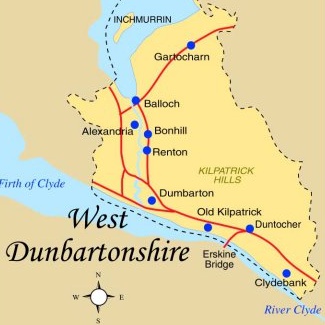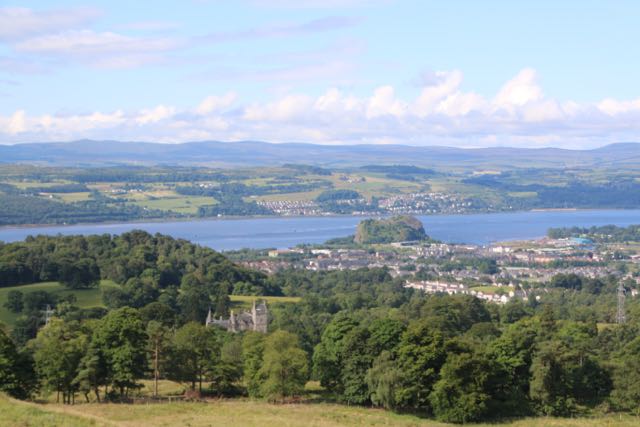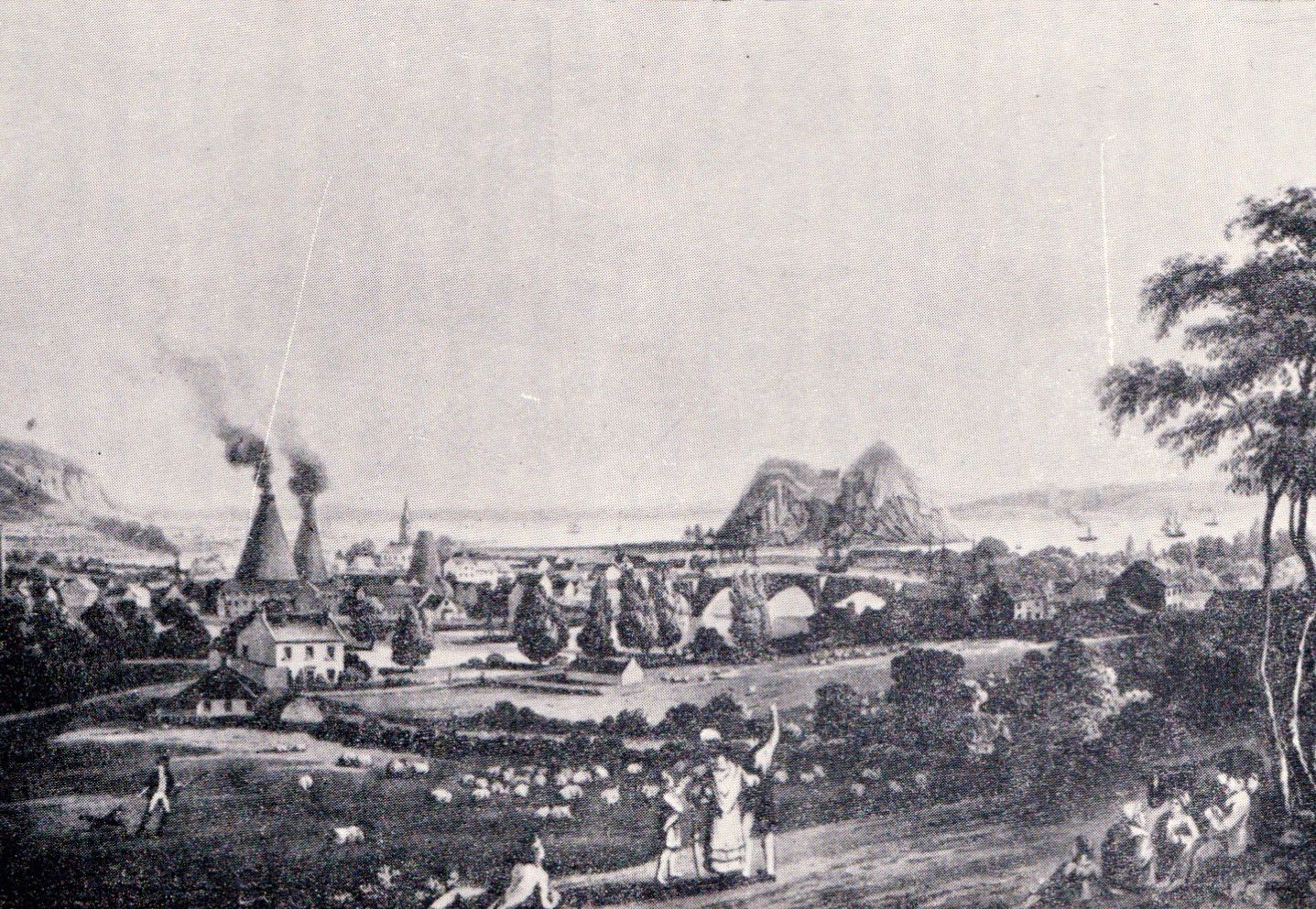
Dumbarton

Early history of the town
Dumbarton is not a tourist
hot spot but many tourists will pass through or bypass the town on
their way from Glasgow to the western highlands and if you enjoy
history then the town has much to offer. Most of the history of
Dumbarton revolves around the Rock and its castle. Dumbarton Rock
has a longer record of continuous occupation than any other
fortress in Britain and was the stronghold of the kingdom of
Alclud, and the centre of British power in northern Britain for
more than two centuries from the mid-seventh century, until the
Vikings destroyed the fortress after a four month siege in 870.
When Gaelic became the dominant language of Scotland, Alclud (which
meant “rock of the Clyde”) was replaced with Dun Breatann meaning
“fortress of the Britons” and this went through various corruptions
until it became Dumbarton.
Dumbarton Castle, which sits on Dumbarton Rock, was used to imprison William Wallace for a short time after his capture by the English. In the early 1500’s, Dumbarton was an important port of departure for France and on September the 25th 1523, The Duke of Albany set sail with a fleet of 87 ships and 4,000 soldiers. Difficult to imagine that scene. Mary Queen of Scots stayed in the castle for around 6 months in 1548 at the age of six before being conveyed to France for safety and some years later Mary was trying to reach Dumbarton Castle when she suffered her final defeat at Langside near Glasgow.
The castle was believed to be impregnable because of its position on the steep sided rock but in March 1571 a force of about 100 men successfully breached the castle’s defences using ropes, ladders and long poles with hooks. In more recent times the rock has attracted the best climbers in the world and the Scottish climber Dave MacLeod has established what is perhaps the world's hardest traditional rock climb which he has called Rhapsody. You can see his attempts to climb the route on YouTube
More recent times
A very good view of the
castle rock can be had from the M8 between the Erskine Bridge and
Greenock but it is not nearly so obvious as you pass through
Dumbarton with a very modest and missable sign, pointing down a
side street, being the only clue to its existence. In 2015 measures
are being taken to make more of the castle and its history and to
encourage more people to visit it. A walk up to the top of the
castle rock gives very rewarding views over the river and of the
town. A video about the castle and rock by Tom Weir is available
on
YouTube
During the 19th century, Dumbarton was a centre for glassmaking, shipbuilding and whisky distilling but it is now mainly a commuter town with a population of around 20,000.
There were many shipbuilding yards and a great many ships were built in the town, the most famous of which is probably the Cutty Sark. She was one of the final tea clippers to be built, and one of the fastest.
The last major Dumbarton shipyard was William Denny which closed in 1963. William Denny was an innovative company and they even built an early design of helicopter in 1909 and later they were involved in hovercraft development. During the Second World War a firm called Blackburn Aircraft produced Sunderland flying boats from a factory near Denny's shipyard. Denny’s shipyard pioneered steel-hulled ship production and the Rotomahana built in 1879 was the first ocean going ship to have a hull made of mild steel.
Dumbarton is home to the Scottish Maritime Museumwhich is built around a ship model testing tank that was built by Denny’s. The tank is about the length of a football field and it was the first in the world allowing calculations about hull design and propulsion requirements to be made rather than waiting to see how the finished design performed. The museum is well worth a visit and has photographs of some of the many ships that were built in Dumbarton and details of where they went in the world.
Whisky production has played a prominent part in the town’s history and the brand most associated with Dumbarton is Ballantine’s and its distinctive rectangular brown bottle. Ironically, it is quite difficult to find that bottle on shelves locally but when on holiday in obscure parts of France or New Zealand it is often the only bottle to be found in the supermarket.
The firm of George Ballantine was bought by Hiram Walker, a Canadian firm, in 1938 and a huge red brick distillery was built on the River Leven right in the town centre which it dominated for more than 60 years. The remnants of that distillery can be seen in the video but it has now been demolished and although whisky bonds and bottling facilities still exist elsewhere in the town, there is no longer any whisky production.
The River Leven flows through the centre of the town and presents a pretty picture with boats moored in the middle as it winds towards the castle and the Clyde. Dumbarton forms part of a conurbation of over 40,000 when you add the towns of Alexandria, Renton and Bonhill that lie on the banks of The Leven between Dumbarton and Loch Lomond at which point the majestic scenery of The Highlands and The Trossachs begins.
The Rock of Ages video shows scenes from an event staged by Historic Scotland. Historic Scotland are custodians of Dumbarton Castle and many other historic Scottish landmarks. They regularly stage events which are designed to illustrate Scotland’s history against the backdrop where the events took place. In June 2018 one of these events was staged at Dumbarton Castle using re-enactment actors to play the parts of the people who have lived, worked, fought and been imprisoned in and around the castle - Romans, invading Norsemen, Scottish freedom fighters and romantic characters such as Mary Queen of Scots. The actors also give demonstrations of how people lived and made things such as pottery and bows and arrows to give an impression of how life might have been around the castle many years ago. The event also had an impressive flying display by a WW1 biplane to remind us of more recent conflicts in the life of the castle. The event concluded with a march past of all the participating groups depicting the history of the castle going back to Roman times - explaining why the castle can be called the rock of ages

Dumbarton Rock and Castle with the River Leven flowing
in front of it out to The Clyde

View of Dumbarton from Lang Craigs which overlook the town.
Overtoun House is in the foreground of the picture

A print depicting the town in the time of the glassworks circa late 18th century
The video below attempts to convey an impression of the town, its history and some of the sites to be seen and places to visit.
ronnie@outandaboutinscotland.co.uk